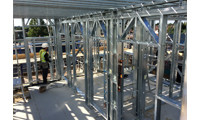

Steve Thompson, Managing Director of steel framing solutions manufacturer EOS Facades, offers his perspective on the ‘offsite revolution’.
A number of industry reports reinforced by government and major investment announcements have increased momentum in the offsite sector. This scale of investment has not been witnessed before and many believe that there is an ‘offsite revolution' taking place - a change that is predicted to see ‘traditional' construction methods being phased out in a number of sectors. This represents a major opportunity for those operating in the offsite industry, but it is not without challenges.
This time around there, is a feeling that the push for offsite construction is sustainable, due to the imposed drivers for change. A significant difference between the present and the previous offsite boom is the emergence of Building Information Modelling - this has been a game-changer for EOS Facades.
Without doubt, BIM is having an impact on the genuine adoption of Design for Manufacture and Assembly protocols, which significantly aides the offsite manufacturer's ability to address the issue of standardisation. BIM facilitates the opportunity for further upstream integration of components and systems and will therefore no doubt, generate new types of offsite manufactured technologies. Fundamentally, DfMA requires the design team to shift their thinking away from ‘construction' to ‘assembly'.
There are, of course, a number of challenges to the growth of offsite. The lack of investment is frequently linked to a lack of certainty of demand or continuity of business. Construction is typically a project-based activity - therefore the customer base can be difficult to retain.
EOS Facades approach to this is two-fold. We have formed strategic alliances with some of the UK's largest developers and main contractors, such as Barratt London and Kier Construction, as well as establishing partnerships with major installers including Ardmore Group and SCL. Offering partnership services for conceiving, designing and manufacturing light gauge steel frame solutions - we are known for building excellent working relationships based on customer needs. This approach offers benefits to all - working relationships and processes are established, teams have no learning curves and importantly, we have built trust through reliability and meeting exacting expectations.
A major extension to our factory has just been completed and the development of a new fabrication plant. We have invested in our own fabrication plant to be self-sufficient in manufacturing our ancillary parts such as angles, brackets, windows and cills. This will support our market leading ‘lump-sum', all-inclusive pricing initiative and complement our ‘total supply' offering.
In addition to the five Howick steel framing machines currently in operation, to further expand the manufacturer's product portfolio and capacity, we have invested in a new multiwidth (boxer) machine and installed overhead cranes for lifting and moving frames and steel coils around the extended facility. This work has been undertaken in preparation for the increased workload with the development of a complete walling solution and load-bearing penalisation to support offsite initiatives.
Beyond the traditional LGSF markets, EOS Facades regard the development of volumetric modular and pod products as becoming increasingly important. These types of systems are best suited to projects where modules form complete rooms, allowing extensive factory finishing and high levels of repeatability. Volumetric modular structures preclude the need for infill or oversail panels and represent to the next evolutionary step for the offsite sector.
Offsite construction, the process of taking the building activity away from the site and into a manufacturing environment, is now potentially one of the fastest growing industry sectors in the UK. It represents the natural industrialisation of conventional construction processes, moving the traditional site practices into the modern factory environment.
Contemporary offsite construction sector technologies and products are now many evolutions apart from the technology of their roots, supported by third party accreditations and testing that make it more advanced than traditional construction methods, and now a readily accepted construction method.
It is clear that the drivers for change vary but most would cite predictability programme and cost - our market leading all-inclusive fixed price packages further enhance the usual price assurances delivered by offsite technology. Improved quality through the use of BIM technology and manufacture in controlled factory environments - are other important factors. This reduces clashes, errors onsite and snagging - together with enhancing the performance throughout lifecycle of the building. And finally, but not exclusively - offsite methods address the skills shortage, as less onsite labour is required together with the reliance on traditional site-based skills.
The publication of the ‘Offsite manufacture for construction: Building for Change' report by the House of Lords Science and Technology Select Committee - will keep the offsite sector on its current trajectory if the recommendations are implemented.
In my opinion, one of the report's key and most important recommendations, is that the Government should encourage the use of offsite manufactured solutions through policy measures. There is an opportunity here for the UK to extend our position at the forefront of offsite manufacturing globally - such a policy would further strengthen the confidence in the offsite supply-chain and encourage greater investment in innovation in offsite technologies, together with research and development.